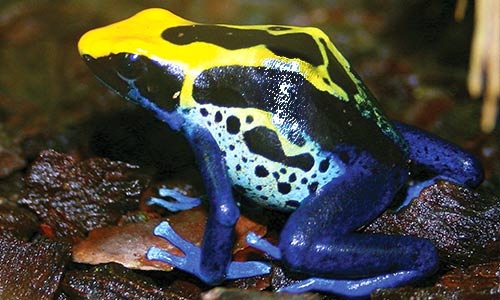Appearance:
The dyeing poison dart frog is found in a wide variety of colors and patterns, including sapphire blue, yellow, and black. It has a pastel yellow head with two dorso-ventral stripes running the length of its body. These stripes may be connected by yellow bands encircling several patches of blue spots on the frog’s back. Their arms and legs are black or deep blue, speckled with bright yellow or black spots. These color patterns aren’t typically developed until the late tadpole stage.
Like with other poison frogs, their bright colors serve as a warning to predators that they’re toxic. The dyeing frog’s skin is covered with toxic alkaloid poisons that can paralyze or kill a predator. Adhesive pads on the frogs’ fingers and toes facilitate climbing. Males can be distinguished from females due to their larger finger discs, which are also cut straighter across the tips.
Size:
- Length: 1.5 to 2 inches; females are larger than males
- Weight: Males can weigh up to approximately .13 ounces; females may way as much as .23 ounces
Diet:
Ants, termites, small spiders, and other small insects.
Reproduction:
The male frogs calls to attract a female mate. If receptive, the female will approach the male, and he will guide her, through a series of courtship motions, to suitable egg-laying sites in his territory. Females lay a clutch of eight to 15 eggs, which are later fertilized by the male. After deposit, the female leaves the male to guard the eggs. Once they hatch, the male frog carries tadpoles to a large pool. Sometimes tadpoles from multiple males are deposited in one large water hole. Tadpoles can be very aggressive, feeding on almost anything, including other tadpoles. They reach transformation size in about ten weeks.
Behavior:
These frogs are diurnal, most active during the morning and early evening hours in search of food and mates. They are usually quite secretive, keeping to protected spots in leaf litter on the forest floor. They’re good climbers and are often found on sides of trees and in heavy vines 1-2 meters above the ground, where their bright yellow stripes stand out in the darkness of the forest. Both sexes are territorial and may wrestle to defend their established area. Only male dyeing frogs vocalize.
Habitat/range:
The dyeing frog inhabits small isolated pockets in French Guinea and rainforests in northeastern Brazil. Frogs spend much of their time in trees or the moist leaf litter of the rainforest floor.
Median Life Expectancy:
Unknown in the wild, but likely about five years
Fun Facts:
- The dyeing poison dart frog gets its name from a legend that people used the frog’s skin to dye parrot feathers from green to red, a technique called tapirage.
- This was the first poison frog known to Europeans.
- The frogs’ toxicity comes from the ants or other insects they eat in the wild. Captive-bred poison dart frogs are not toxic due to their different diet.



